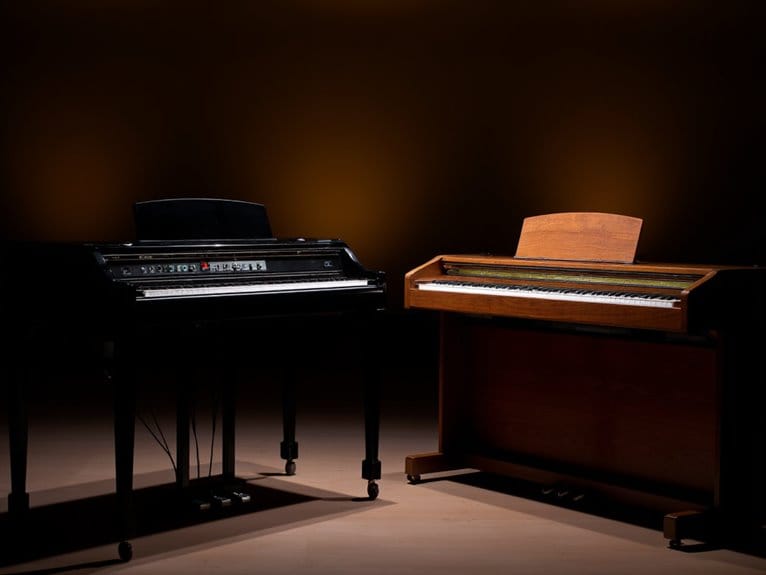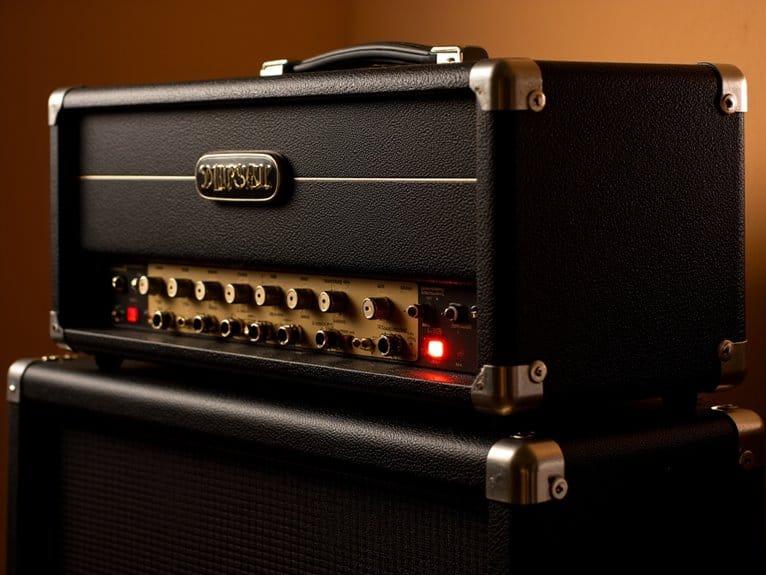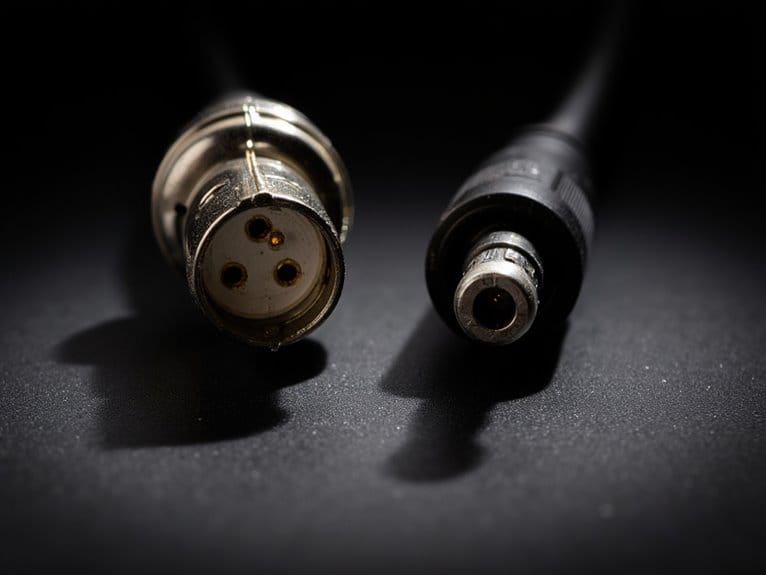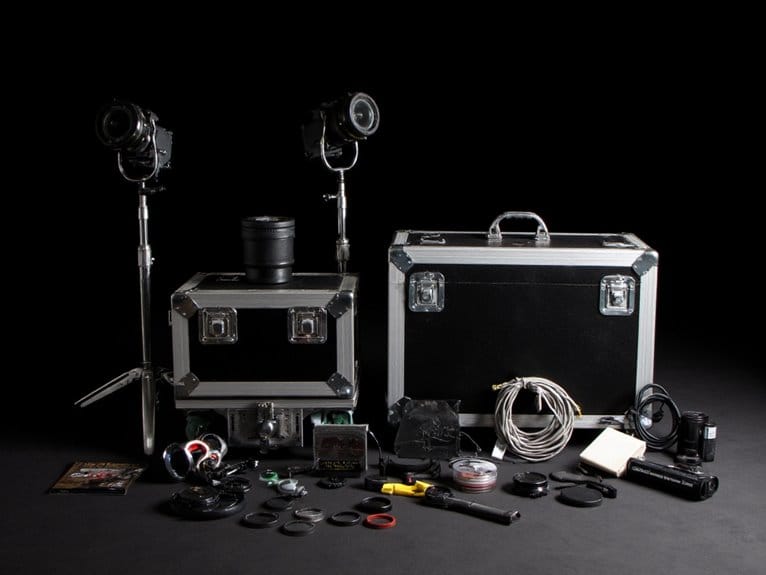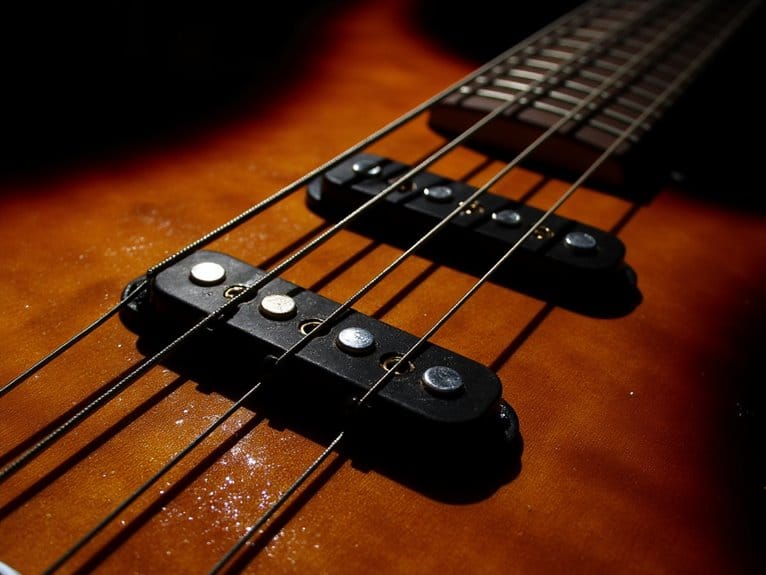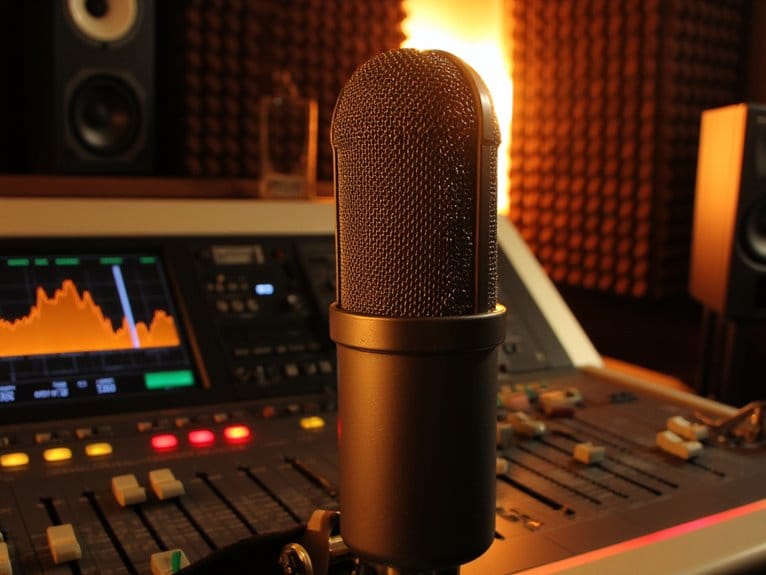Stage Pianos Vs Home Digital Pianos: What’s the Difference
Stage pianos prioritize portability and versatility, weighing 33-66 pounds with rugged construction designed for live performances, featuring extensive sound libraries including electric pianos and synths alongside real-time control knobs and sliders. Home digital pianos emphasize authentic acoustic reproduction through console-style cabinetry, larger built-in speakers, and educational features like lesson modes, typically costing $500-$1400 compared to stage models starting around $2000. Understanding these fundamental differences will help you navigate the specific features that matter most for your musical goals.
We are supported by our audience. When you purchase through links on our site, we may earn an affiliate commission, at no extra cost for you. Learn more.
Notable Insights
- Stage pianos are portable (33-66 pounds) with rugged construction for touring, while home models feature console-style cabinetry mimicking acoustic pianos.
- Stage pianos offer versatile sound engines with multiple instruments and synth sounds, while home models focus on authentic acoustic piano reproduction.
- Home digital pianos have larger multi-driver speaker systems for room projection, while stage pianos use smaller speakers designed for external amplification.
- Stage pianos emphasize real-time controls like knobs and sliders for live performance, while home models prioritize educational features and practice tools.
- Stage pianos target professional musicians starting around $2000, while home models serve beginners and hobbyists ranging from $500-$1400.
Portability and Design Considerations
The fundamental divide between stage pianos and home digital pianos becomes immediately apparent when you consider their approach to portability and design philosophy.
Stage pianos prioritize transport logistics, weighing between 33-66 pounds with compact, rugged exteriors built to withstand touring conditions, while home digital pianos embrace console-style cabinetry that mimics traditional acoustic pianos but sacrifices mobility.
Stage pianos sacrifice aesthetics for mobility, while home digitals trade portability for elegant console designs that complement living spaces.
You’ll find stage pianos feature minimalist, no-frills designs optimized for quick setup and frequent moving, whereas home models focus on aesthetic appeal with polished finishes designed to complement your décor. The reduced setup time with stage pianos makes them particularly advantageous for performers who need to configure their equipment quickly between venues.
Home digital pianos incorporate built-in speakers that eliminate the need for external amplification in practice settings.
Understanding these fundamental differences helps align your choice with user preferences, whether you need a reliable performer that travels well or an elegant instrument that stays beautifully stationary.
Sound Quality and Variety Differences
When you’re comparing stage pianos to home digital pianos, you’ll notice that the fundamental approach to sound generation, sample libraries, and speaker configurations creates distinctly different audio experiences that serve their respective purposes.
I’ve found that stage pianos typically prioritize versatile sound engines with multiple instrument categories, extensive sample memory, and professional-grade output systems designed for live performance environments, while home digital pianos focus their resources on authentic acoustic piano reproduction with detailed samples, sympathetic resonance modeling, and integrated speaker systems optimized for residential use. Stage pianos often feature MIDI and USB connectivity options that allow seamless integration with recording equipment and other musical devices for professional applications.
The differences in sound sample quality, variety, and speaker implementation directly impact how these instruments perform in their intended settings, affecting everything from tonal authenticity to practical usability.
Sound Sample Differences
Although I’ve spent countless hours comparing digital pianos, I’m still amazed by how dramatically sound sample differences can influence your playing experience between stage and home models.
Stage pianos excel through sophisticated sampling techniques that capture multiple instrument categories, while home digital pianos concentrate on perfecting acoustic piano authenticity.
Here’s what separates them:
- Sample Library Scope: Stage pianos offer extensive libraries including electric pianos, organs, and synths, whereas home models focus primarily on grand piano samples with minimal additional voices.
- Sound Layering Capabilities: Stage pianos provide advanced sound layering, splits, and real-time manipulation features for performance versatility, while home models maintain simpler, static configurations.
- Engine Technology: Stage pianos utilize hybrid sampling and modeling approaches for diverse sounds, while home pianos optimize multi-sample playback specifically for acoustic piano resonance and sustain characteristics. Home models often incorporate AiR sound source technology to enhance the realism of acoustic piano reproduction.
For optimal sound quality, prioritize models with high polyphony of 128 or more voices, as this prevents note cutoff during complex passages and layered sounds. Digital pianos with advanced sound chips deliver more realistic tones and expand the overall musical expression capabilities.
Speaker System Variations
Beyond how these pianos capture and process their sounds, speaker system variations create equally dramatic differences in your daily playing experience, particularly when you’re deciding between portability and room-filling sound quality.
Home digital pianos feature larger cabinets housing multi-driver systems with woofers and tweeters, typically delivering 12-20+ watts for balanced frequency reproduction and natural sound projection throughout your room. Their speaker technology simulates acoustic piano soundboards through carefully tuned enclosures and strategic driver placement.
Stage pianos, conversely, sacrifice built-in audio quality for portability, incorporating smaller single-driver speakers with lower wattage since they’re designed expecting external amplification through PA systems or active monitors for professional performance volume and clarity.
Built-in Features and Control Options
When you’re comparing stage pianos to home digital pianos, you’ll notice that each category prioritizes dramatically different control philosophies.
Stage models emphasize real-time manipulation through extensive knobs, sliders, and programmable interfaces designed for live performance dynamics. Your home digital piano focuses on streamlined, user-friendly features like built-in metronomes, recording capabilities, and simplified sound selection menus that support practice sessions and educational activities rather than complex on-stage adjustments.
I’ve found that understanding these fundamental differences in control design helps you choose the instrument that matches your primary playing environment, whether that’s commanding a live audience or perfecting your technique in a quiet practice room.
Live Performance Controls
Once you’re standing on stage with hot lights bearing down and an audience waiting, you’ll quickly discover that fiddling with complicated menu systems isn’t exactly feasible—which is precisely why stage pianos come loaded with dedicated physical controls like knobs, sliders, and color-coded switches that let you make real-time adjustments without breaking your performance flow.
These tactile interfaces enable live dynamics and performance adaptability that home digital pianos simply can’t match, with LED indicators providing visual feedback in dimly lit venues.
Stage pianos deliver superior performance control through:
- Instant sound switching between songs without audio cutoffs or awkward pauses
- Live Set banks that recall complex layered setups and effects parameters instantly
- Real-time effect manipulation using dedicated controls for EQ, compression, and reverb adjustments
Home models prioritize simplicity over performance flexibility.
Home Practice Features
Convenience becomes the defining advantage when comparing home digital pianos to their stage counterparts, as manufacturers pack these instruments with an all-encompassing array of built-in features designed specifically for practice, learning, and casual enjoyment in residential settings. You’ll discover extensive practice modes including metronomes, lesson functions, and multi-track recording capabilities that transform your home sessions into structured learning experiences. Just as content creators benefit from plug-and-play connectivity in modern recording equipment, home digital pianos offer seamless integration with computers and devices for expanded functionality.
| Feature Category | Home Digital Piano Benefits |
|---|---|
| Sound Variety | 10-700+ voices, multiple sound engines, acoustic emulation |
| Recording Tools | Multi-track recorders, USB storage, rhythm accompaniments |
| Learning Tools | App integration, LED indicators, split/layer functions |
These learning tools, combined with Bluetooth connectivity and headphone outputs, create an immersive practice environment that I find particularly valuable for developing musical skills without disturbing household peace. Educational features like lesson modes often include teacher-student collaboration functions that divide the keyboard into separate zones, enabling effective instruction and guided practice sessions. Modern home digital pianos often include zero-latency monitoring capabilities for real-time audio feedback when connected to external recording devices.
Construction and Durability Factors
While both stage and home digital pianos share the fundamental goal of recreating an authentic acoustic piano experience, their construction philosophies diverge dramatically based on their intended environments and usage patterns.
When you’re examining material robustness, stage pianos utilize heavier, more durable casing designed to withstand the rigors of frequent transport and rough handling during tours. Their structural design emphasizes portability, typically weighing 33-66 pounds while omitting built-in stands and speakers to reduce weight and potential failure points.
Stage pianos sacrifice aesthetics for durability, featuring reinforced casings that endure touring demands while maintaining essential portability for professional musicians.
Consider these key construction differences:
- Durability focus: Stage models resist vibrations and environmental variability better than home units.
- Modular design: Removable pedals and replaceable mechanisms accommodate touring wear.
- Integration approach: Home pianos feature fixed cabinetry with integrated speakers and stands.
Home digital pianos prioritize aesthetic appeal and convenience over ruggedness since they remain stationary.
Target Users and Practical Applications
Understanding your specific needs becomes crucial when choosing between stage and home digital pianos, as each category serves distinctly different musicians with varying performance requirements and lifestyle constraints. Professional performers prioritize portability, external amplification compatibility, and quick sound adjustments for diverse performance settings, while home pianists focus on authentic weighted keys, built-in speakers, and elegant aesthetics matching their living spaces.
| Feature | Stage Pianos | Home Digital Pianos |
|---|---|---|
| Primary Users | Professional musicians, touring performers | Beginners, students, hobbyists |
| Setup Environment | Live venues, studios, mobile setups | Fixed home locations, teaching studios |
| Sound System | External amplification required | Built-in speakers included |
| Portability Priority | Essential for gigs and travel | Minimal – permanent placement preferred |
Your user preferences ultimately determine which instrument aligns with your musical goals and practical requirements.
Pricing and Total Cost of Ownership
Most buyers discover that the sticker price represents just the beginning of their financial commitment, as both stage and home digital pianos carry distinct cost implications that extend far beyond the initial purchase.
Here’s what you’ll encounter cost-wise:
- Upfront Investment: Stage pianos typically start around $2000 for professional models, while home digitals range from $500-$1400, with furniture cabinet styles like the Casio PX-870 hitting $1100-$1200.
- Equipment Expenses: You’ll need amplifiers, PA systems, and protective cases for stage pianos, whereas home models include speakers and often furniture stands.
- Long-term Ownership: Stage pianos retain better resale value through professional demand, though both benefit from warranty options and financing plans that major brands offer.
Frequently Asked Questions
Do Home Digital Pianos Work Well for Recording in Studios?
You’ll find home digital pianos work excellently for studio recording since they provide clean digital audio output through USB connections. Their recording quality depends on internal sampling, offering professional results without microphones or acoustic treatment.
Are the Key Actions Different Between Stage and Home Pianos?
Yes, you’ll notice key action comparison reveals distinct differences in your playing experience. Stage pianos prioritize durability and responsiveness for live performance, while home digitals focus on replicating acoustic piano feel for practice.
On a final note
Whether you’re eyeing a sleek stage piano for gigs or considering a feature-packed home digital for family use, your choice ultimately depends on your specific needs, space constraints, and budget. Stage pianos excel in portability and professional connectivity, while home digitals offer extensive learning tools and built-in speakers. You can’t go wrong with either option if you’ve honestly assessed your playing environment, skill level, and long-term musical goals.

